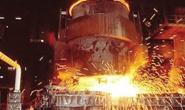Economy

Tight Supply of Electrodes Jolts Stainless Minimills
Written by Tim Triplett
October 12, 2017
Tight supplies of graphite electrodes used in the electric arc furnace steelmaking process have raised electrode prices to the point that at least two stainless steel mills have increased their surcharges.
Outokumpu was the first with a surcharge of 30 euros (about $35.50) per metric ton on Sept. 27 in most markets except the U.S. AK Steel followed with a $13.20 per short ton electrode surcharge effective with November shipments.
China produces 70-80 percent of the world’s supply of graphite, which is used to make the electrodes that melt the scrap. It is also used in the production of lithium ion batteries. Recent environmental policies in China have closed mines and lowered production. China also has imposed a 20 percent export duty on graphite and a 17 percent VAT to help protect its graphite industry. Graphite prices have increased by 25-30 percent in the last couple of months. Prices are currently up to $1,100 per ton, but still well below the 2012 peak of $2,800 per ton, MetalMiner reports.
Electrodes are consumed in the steelmaking process and must be replaced every 8-10 hours. In its recent analysis on how this surcharge may affect stainless prices, MetalMiner estimates that electrodes represent about 9 percent of the total cost to produce one metric ton of steel, or around $43.22 per metric ton.
Steel Market Update’s expert sources note that the process to make stainless steel consumes electrodes more rapidly than production of carbon steel. The electrode cost as a percentage of the total may actually be lower for stainless steel than carbon steel because of the high cost of stainless alloys which are included in the EAF melt (carbon steel does not add alloys to their melt).
Buyers of carbon steel should be aware of the higher costs associated with graphite electrodes as there may come a time when the domestic steel mills may come out with either a surcharge or price increase related to the costs associated with their electrode use. The mills we have discussed this with in the recent past have told us that their sources of supply are fine. The question in SMU mind is what will their costs be come 2018 and beyond if the issues continue to exist in China?

Tim Triplett
Read more from Tim TriplettLatest in Economy

Fed Beige Book: Economy improves, but manufacturing weak
While general economic conditions across the US improved slightly over the last six weeks, activity in the manufacturing sector was weak, according to the Fed’s latest Beige Book report.

SMU Community Chat: Simonson with the latest on construction
A lot of economists were predicting a recession last year. Ken Simonson, chief economist for The Associated General Contractors of America (AGC), wasn’t one of them.

Housing starts slip to seven-month low in March
Following a strong February, US housing starts eased through March to a seven-month low, according to the most recent data from the US Census Bureau.

Manufacturing activity in New York state continues to soften
New York state saw a continued decline in manufacturing activity in April, according to the latest Empire State Manufacturing Survey from the Federal Reserve Bank of New York

Worldsteel projects steel demand to grow 1.7% this year
Global steel demand will reach roughly 1.793 million metric tons (1.976 million short tons) this year, an increase of 1.7% over 2023, the World Steel Association (worldsteel) said in its updated Short Range Outlook report. The gain will come after a 0.5% contraction in steel demand in 2023. Demand is forecasted to increase another 1.2% […]
